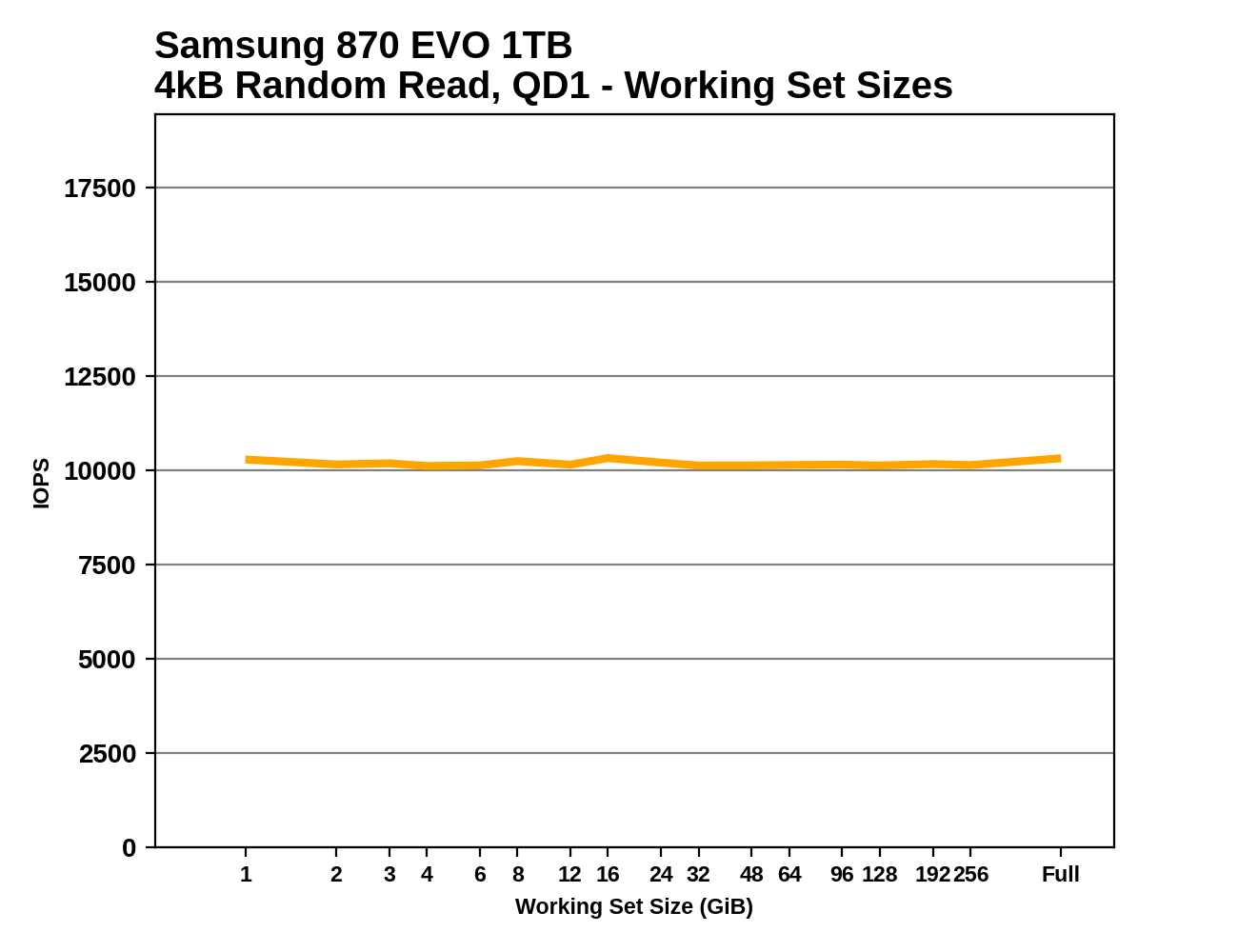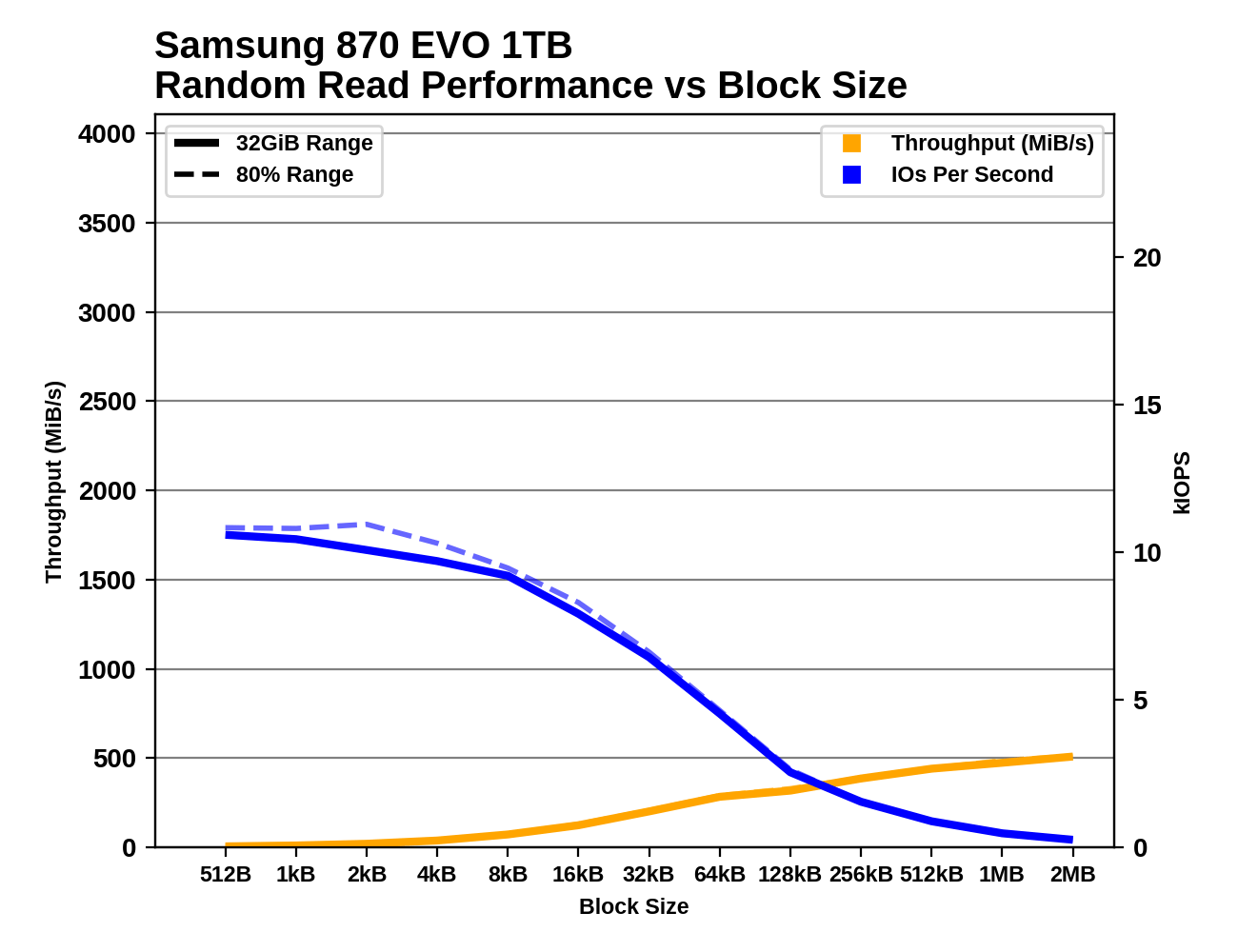The Samsung 870 EVO (1TB & 4TB) Review: Does the World Need Premium SATA SSDs?
by Billy Tallis on February 17, 2021 8:00 AM ESTAdvanced Synthetic Tests
Our benchmark suite includes a variety of tests that are less about replicating any real-world IO patterns, and more about exposing the inner workings of a drive with narrowly-focused tests. Many of these tests will show exaggerated differences between drives, and for the most part that should not be taken as a sign that one drive will be drastically faster for real-world usage. These tests are about satisfying curiosity, and are not good measures of overall drive performance. For more details, please see the overview of our 2021 Consumer SSD Benchmark Suite.
Whole-Drive Sequential Fill
 |
|||||||||
| Pass 1 | |||||||||
| Pass 2 | |||||||||
Some of our other tests have shown a few signs that the 870 EVO's write performance can drop when the SLC cache runs out, but this straightforward sequential write pass over the entire drive doesn't reveal any such behavior. The 870 EVO's sequential write performance is extremely consistent, even on the second write pass.
 |
|||||||||
| Average Throughput for last 16 GB | Overall Average Throughput | ||||||||
Due to the excellent performance consistency, the Samsung 870 EVOs edge out the other SATA drives with marginally higher average sequential write speeds. The entry-level NVMe drives end up much worse off than the mainstream SATA drives once their caches run out, but the more mainstream NVMe drive blows them all away.
Working Set Size
 |
|||||||||
As expected, the Samsung 870 EVO's random read performance shows basically no variation across a range of working set sizes, and that read performance is at least a little bit faster than any of the other SATA drives or the entry-level NVMe drives.
Performance vs Block Sizes
 |
|||||||||
| Random Read | |||||||||
| Random Write | |||||||||
| Sequential Read | |||||||||
| Sequential Write | |||||||||
There are no particular surprises in how the Samsung 870 EVO handles IOs of different block sizes. Unlike some drives, it has no trouble with sub-4kB IOs. It offers moderate improvements over the 860 EVO for mid-sized random reads (up to about 128kB). The one negative is that for writes we again see more inconsistency from the 870 EVO than the 860 EVO when testing an 80% full drive. The simple whole-drive sequential write test may not have been able to reveal any SLC caching troubles, but it does seem clear that the caching behavior has some performance regressions for more complicated workloads on a drive that's more well-used—though it's still unlikely to matter for any typical real-world consumer workload.










136 Comments
View All Comments
Kamen Rider Blade - Thursday, February 18, 2021 - link
That's why I buy & use SATA BackPlanes =DCooperdale - Saturday, February 20, 2021 - link
My motherboard has SATA Express support. Not a SATA upgrade as much as a kind-of-hybrid between SATA and NVMe. But yes I see what you mean. It failed miserably though.Juraj_SK - Wednesday, February 17, 2021 - link
I think SATA is dead. Even with a newer version it's still a terrible interface for drives. Not only it doesn't provide power (so you need a separate cable from the PSU), but the drive itself needs a box and the whole thing takes a lot of space (often wasted inside - you could literally cut some SSD in half and it would still work :D).Whereas NVMe is chip only, super small, power included. No wasted cables or materials and it's connected with PCIe just like everything else.
eek2121 - Wednesday, February 17, 2021 - link
NVME is limited by surface area, so I wouldn’t count SATA as being dead yet. A SATA drive will always be able to hold more data than an NVME drive.DanNeely - Wednesday, February 17, 2021 - link
Except at the silly fringe that doesn't matter though. A sata drive packing more flash than can fit into an m.2 is going to be crazy expensive for a consumer model; and in the enterprise market taking several times longer than an m.2 drive to fill (think initial fill or raid rebuilds) is a major liability.eek2121 - Wednesday, February 17, 2021 - link
It isn’t a silly fringe thing. There are legitimate needs for bulk storage. One of my clients has a database that is 44TB in size.Guspaz - Wednesday, February 17, 2021 - link
Except for enterprise use there are already pcie-based connection standards for 2.5” drives. SATA isn’t needed for that.schujj07 - Wednesday, February 17, 2021 - link
If you have a 44TB DB that would be placed on a physical SAN typically. The only other possibility is the entire DB is a physical appliance. Either way the server will have multiple 2.5" drive bays. Depending on the age of the server, those slots will either be SATA/SAS, SATA/SAS/NVMe, or strictly NVMe. Either way both SAS and NVMe have drives larger than 15TB. Outside of one company (and that is a 3.5" SSD), the largest Enterprise grade SATA SSD are 7.68TB now. Sure you can purchase older ones on SATA that are larger, but with the rapid adoption of NVMe there isn't any reason to go SATA unless absolutely required. Also when it comes to cost, SATA Enterprise SSD isn't much cheaper than Enterprise NVMe, SAS is still overpriced though.CaedenV - Wednesday, February 17, 2021 - link
"It isn't a silly fringe thing" and then proceeds to put forward an extremely fringe case.Just how many people have a 44TB DB laying around their house? This is consumer equipment. Don't put a 44TB DB on consumer equipment!
stancilmor - Thursday, February 18, 2021 - link
44TB? That is small potatoes. I’m dealing with storage requirements in double digits of PB annually. Certainly not consumer level when just drives cost in the millions.For home use I rely on the hot plug feature of SATA. For the hot plug feature I’ll be switching to USB C, USB 4 or thunderbolt 3 or 4. I still don’t have an M.2 Drive, but likely the next system upgrade will include an M.2 for the OS. SATA is getting to be too slow.
As for the Samsung drives. I recently upgraded an aging laptop’s mechanical drive with the EVO 870 simply, because the 860 had too long of a shipping time.
I also almost exclusively use Samsung drives in upgrades, because of how well the Samsung data migration tool works. I have tried Acronis and use clonezilla, both have created unusable clones on occasion. Samsung’s Data Migration just works, even on a running system.